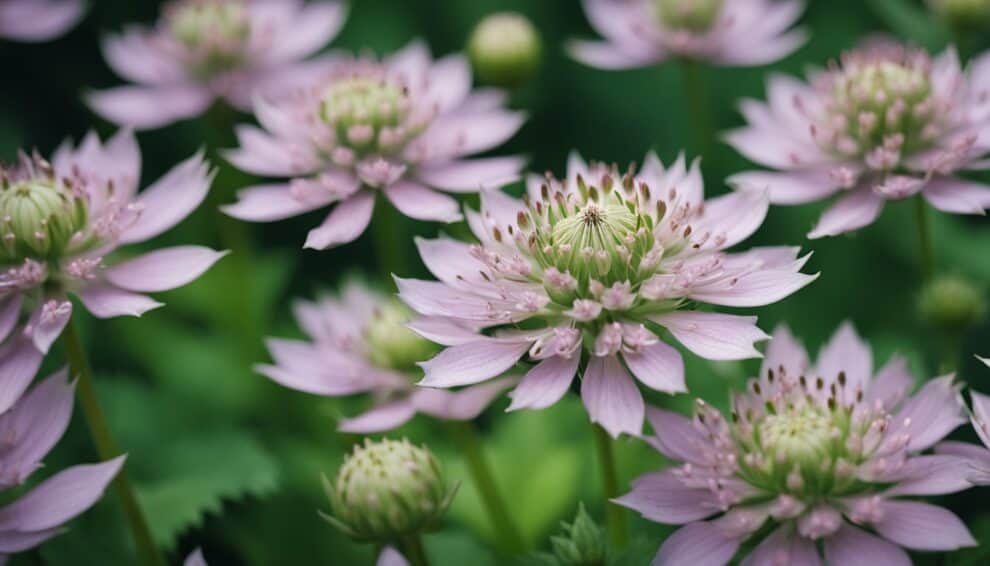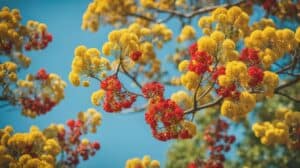Astrantia Major, commonly known as Masterwort, is a beautiful and unique plant that has been gaining popularity among gardeners in recent years.
With its stunning flowers and delicate foliage, it is no wonder why this plant has become a favorite among those who enjoy gardening.
However, caring for this plant can be challenging, and it is important to understand its needs to ensure its health and longevity.

One of the most important aspects of caring for Astrantia Major is providing it with the right growing conditions.
This plant prefers moist, well-drained soil and partial shade, making it an ideal addition to a woodland garden or shady border.
It is also important to avoid overwatering, as this can lead to root rot and other issues.
With the right growing conditions, Masterwort can thrive and produce stunning blooms year after year.
Another important aspect of caring for Astrantia Major is proper pruning.
This plant should be pruned back in the fall to prevent it from becoming too leggy and to promote healthy growth in the spring.
Deadheading spent flowers throughout the growing season can also help to encourage new growth and prolong the blooming period.
With these simple tips, anyone can master the care of this great Masterwort and enjoy its beauty for years to come.
Understanding Astrantia Major
Historical Significance
Astrantia Major, commonly known as Great Masterwort, has a rich history of medicinal use.
It was used in ancient times to treat a variety of ailments, including fevers, wounds, and digestive issues.
In medieval times, it was believed to have magical properties and was used in love potions.
Botanical Profile
Astrantia Major is a herbaceous perennial plant that belongs to the Apiaceae family. It is native to Europe and Asia and can grow up to 1 meter in height.
The plant has distinctive, star-shaped flowers that bloom in summer and come in shades of pink, red, and white.
The leaves of the plant are deeply lobed and have a serrated edge.
Astrantia Major prefers moist, well-drained soil and partial shade. It can be propagated through division or by sowing seeds in the spring.
The plant is low maintenance and does not require much attention once established.
In summary, Astrantia Major is a beautiful and historically significant plant that can add a touch of magic to any garden.
With its unique flowers and easy care requirements, it is a great addition to any landscape.
Cultivation Essentials

Planting Guidelines
Astrantia Major, commonly known as Great Masterwort, is a perennial plant that grows well in gardens and containers.
It is best to plant Astrantia Major in the spring or fall, as this is when the soil is moist and the temperature is moderate.
When planting, make sure to space the plants about 18 inches apart to allow for proper growth.
Soil Requirements
Astrantia Major prefers well-draining soil that is rich in organic matter. The ideal pH range for this plant is between 6.0 and 7.0.
If the soil is too acidic, add lime to raise the pH level. If the soil is too alkaline, add sulfur to lower the pH level.
It is also important to keep the soil moist, but not waterlogged, as this can lead to root rot.
Light and Temperature Needs
Astrantia Major thrives in partial shade to full sun. It is important to provide the plant with at least 4 hours of direct sunlight each day.
In hot climates, it is best to provide some shade during the hottest part of the day to prevent wilting.
The ideal temperature range for this plant is between 60°F and 75°F.
If the temperature drops below 50°F, the plant may go dormant, but it will come back to life in the spring.
By following these cultivation essentials, gardeners can ensure that their Astrantia Major plants grow healthy and strong.
Maintenance and Care

Watering Techniques
Astrantia Major plants require moist soil, but they should not be overwatered. Overwatering can lead to root rot and other fungal diseases.
The best way to ensure that the soil is moist but not waterlogged is to water deeply once a week.
During hot and dry weather, the plants may require more frequent watering.
It is important to keep the soil consistently moist to ensure that the plants thrive.
Pruning and Deadheading
Pruning and deadheading are essential maintenance tasks for Astrantia Major plants.
Deadheading, or removing spent flowers, encourages the plant to produce more blooms.
It also prevents the plant from going to seed and helps to prolong the flowering period.
Pruning should be done in the spring to remove any dead or damaged stems. This will help to promote new growth and ensure a healthy plant.
Pest and Disease Management
Astrantia Major plants are relatively pest and disease-resistant, but they can still be affected by certain issues.
One of the most common problems is powdery mildew, which can be prevented by ensuring good air circulation and avoiding overwatering.
Aphids and spider mites can also be a problem, but they can be controlled with insecticidal soap or neem oil.
It is important to monitor the plants regularly and take action at the first sign of a problem.
In summary, Astrantia Major plants require consistent moisture, regular deadheading and pruning, and monitoring for pests and diseases.
By following these simple maintenance and care guidelines, gardeners can enjoy a beautiful and healthy display of Great Masterwort in their gardens.
Designing With Great Masterwort

When it comes to designing with Astrantia Major, there are a few things to consider.
This section will explore the landscape uses and companion plants that will complement the Great Masterwort.
Landscape Uses
Astrantia Major can be used in various ways in the landscape. It is a great plant for filling in gaps in the garden, as it is a prolific self-seeder.
It also makes a great cut flower, as its blooms can last for several weeks.
One of the best ways to use Astrantia Major is in mixed borders. It pairs well with other perennials such as Salvia, Echinacea, and Geranium.
It can also be used in cottage gardens, rock gardens, and woodland gardens.
Companion Plants
When it comes to companion planting, Astrantia Major has several options.
It pairs well with plants that have similar growing conditions, such as partial shade and moist soil. Some great companion plants include:
- Hosta: The large leaves of hostas provide a great contrast to the delicate blooms of Astrantia Major.
- Ferns: Ferns make a great backdrop for Astrantia Major, as their foliage provides a lush green backdrop.
- Heuchera: The colorful foliage of Heuchera provides a great contrast to the blooms of Astrantia Major.
In conclusion, Astrantia Major is a versatile plant that can be used in various ways in the landscape.
When designing with Great Masterwort, consider its landscape uses and companion plants to create a cohesive and visually appealing garden.
Frequently Asked Questions

What are the ideal growing conditions for Astrantia Major?
Astrantia Major thrives in a moist, well-drained soil with a pH between 6.0 and 7.0.
It prefers partial shade, although it can tolerate full sun in cooler climates.
It is important to keep the soil consistently moist, but not waterlogged, to prevent the plant from drying out.
How can I extend the vase life of Astrantia cut flowers?
To extend the vase life of Astrantia cut flowers, it is important to cut the stems at an angle and place them in a vase of clean, cool water.
Change the water every two days and trim the stems every time you change the water. Keep the flowers away from direct sunlight and heat sources.
What does it mean when Astrantia leaves die back in winter?
Astrantia leaves die back in winter as part of the plant’s natural growth cycle.
It is important to cut back the dead foliage in early spring to make way for new growth. This will also help prevent the spread of diseases and pests.
How do I properly propagate Astrantia from seeds?
To propagate Astrantia from seeds, sow them in a well-drained soil in early spring or late summer. Cover the seeds lightly with soil and keep the soil moist.
Germination can take up to three weeks. Once the seedlings have grown to a height of 2-3 inches, they can be transplanted to their permanent location.
Can you explain the symbolism behind Astrantia flowers?
Astrantia flowers are often associated with strength, courage, and protection. They are also said to represent gratitude and appreciation.
In some cultures, Astrantia is believed to have healing properties and is used in traditional medicine.
Is the Great Masterwort an invasive plant, and how can I manage its spread?
Astrantia Major is not considered an invasive plant, but it can spread quickly if left unchecked.
To manage its spread, it is important to divide the plant every three to four years and remove any unwanted seedlings.
It is also important to keep the plant well-mulched to prevent the spread of seeds.














